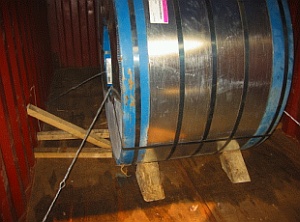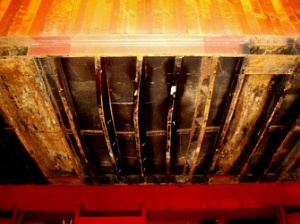However, the loading and transport of heavy steel coils in ISO-containers with high point loads and large free spaces, imposes great demands on the quality of load distribution and securing measures in the container.
Regrettably, these demands are often not complied with. Heavy and extra heavy coils are often pushed into a container with brutal force and then poorly blocked and secured. After the doors are closed, nobody may become aware of the time bomb ticking inside (Figure 1).

Figure 1: Coil of 16 t in a container without bedding,
fixed poorly by wedges and timbers and secured by soft iron wire
The consequences, in the less spectacular case, are containers loosing their approval due to twisted bottom girders and being taken out of service for repairs (Figure 2). In the worst case, while lifting and handling the container, a heavy coil breaks through the bottom and smashes people at work on the factory premises or on board ship.

Figure 2: Container from Figure 1 with extinct
approval due to twisted bottom girders
The appropriate stowage and securing of steel coils in standard containers requires the consideration of the transverse strength of the container bottom and of the longitudinal strength of the whole container, as well as the careful securing of the coils against accelerations in longitudinal and transverse direction.
In view of different weights and dimensions of steel coils there is a variety of solutions of this problem. Therefore, in this guidance steel coils are divided into several classes of weight (mass) and adequate examples of stowage and securing options are presented.
However, in order to offer the user the opportunity to find and verify own solutions, the strength capacity of containers in longitudinal and transverse direction as well as the utilisation of timber and steel beams is presented in detail. Simple rules and diagrams for the correct arrangement and dimensioning are given.
The securing of coils against longitudinal and transverse loads during transport is also highlighted in the loading examples. Securing can be implemented rather uniformly by timber shoring (bracing) and lashing, and checked with a simple balance of forces.